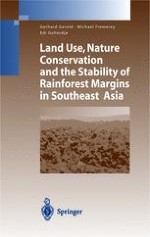Southeast Asia constitutes one of the world's most extended rainforest regions. It is characterized by a high degree of biodiversity and contains a large variety of endemic species. Moreover, these forests provide a number of important and sin gular ecosystem services, like erosion protection and provision of high quality wa ter, which cannot be replaced by alternative ecosystems. However, various forms of encroachment, mostly those made by human interventions, seriously threaten the continuance of rainforests in this area. There is ample evidence that the rainforest resources, apart from large scale commercial logging, are exposed to danger particularly from its margin areas. These areas, which are characterized by intensive man-nature interaction, have been identified as extremely fragile systems. The dynamic equilibrium that bal ances human needs and interventions on the one hand, and natural regeneration capacity on the other, is at stake. The decrease of rainforest resources is, to a sub stantial degree, connected with the destabilization of these systems. Accordingly, the search for measures and processes, which prevent destabilization and promote stability is regarded as imperative. This refers to both the human and the natural part of the forest margin ecosystem.
